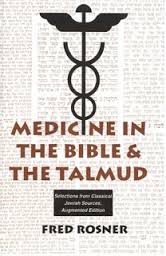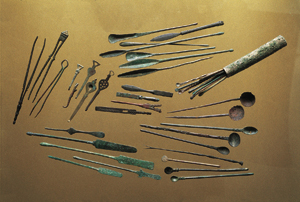Hebrew medicine & the Bible

The main source of information on early Hebrew medicine is the Bible. The Hebrews were, however, influenced in their medical concepts and practices by the surrounding nations, particularly by Egypt, where medical knowledge was highly developed. Prevailing superstitions and beliefs in magic medicine were less accepted by Hebrew, however, than by their neighbours. Nevertheless, the ancient Hebrews attributed health and disease to a divine source. Healing was in the hands of God and the role of doctor was that of helper (or "instrument") of God.
Physicians were drawn from the priestly tribe of Levites and were prohibited from practicing if they had poor eyesight. A number of medications were mentioned in the Bible but there is little reference to surgery apart from ritual circumcision.
Changing times
By the time of the birth of Christ, however, Hebrews were beginning to move away from biblical influences and to establish a more meaningful medical code of their own, documented in the Talmud. This was still heavily influenced by such well-established factors as the four humors (phlegm, yellow bile, black bile & blood) and the four elements of air, earth, fire and water espoused by the Greeks. Considering their Egyptian and Mesopotamian inheritance, suprisingly few medicines were detailed in Hebrew medical literature.
Surgery
Human dissections were rarely performed and most of the anatomical information in the Talmud comes from Egyptian dissections or from examination of animals to determine their health and suitability as kosher food.
The Talmud contains detailed advice on reducing dislocations and managing of injuries to many organs. Some specific techniques are described e.g. the treatment of imperforate anus by incising where the anus should be after oiling and sunburning the skin. Of course, circumcision remained the "seal of the covenant" to be performed on all boys at a proscribed time after birth.
 Circumcision & the seal of the covenant
Circumcision & the seal of the covenant
Although barbers and other uneducated healers performed bloodletting and minor surgical procedures, medicine was practiced by professionals called rophe, and surgery by individuals referred to as uman. Surgical instruments (pictured) were well-developed by this time, including scalpels, forceps, scoops, spoons, probes and curettes.
There are few descriptions of urological diseases or treatments but the Talmud does record various pieces of advice for curing for bladder stones:
.. take three drops of tar and three drops of leek juice and three drops of clear wine and pour it on the penis of a man or on the corresponding place [i.e. the urethra] in a woman. Alternatively he can take the ear of a bottle and hang it on the penis of a man or on the breasts of a woman. Or he can take a purple thread which has been spun by a woman of ill repute or the daughter of a woman of ill repute and hang it on the penis of a man or the breasts of a woman. Or again he can take a louse from a man and a woman and hang it on ...
← Back to Time Corridor